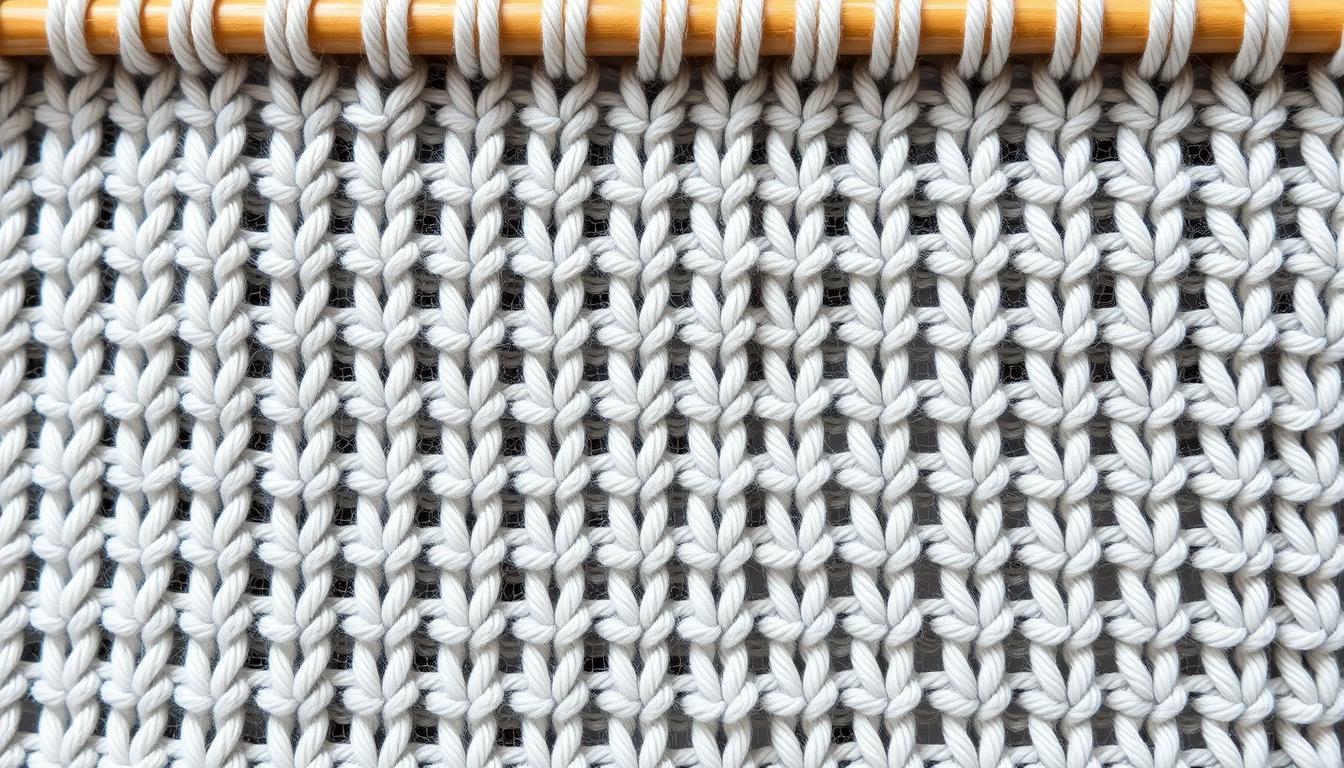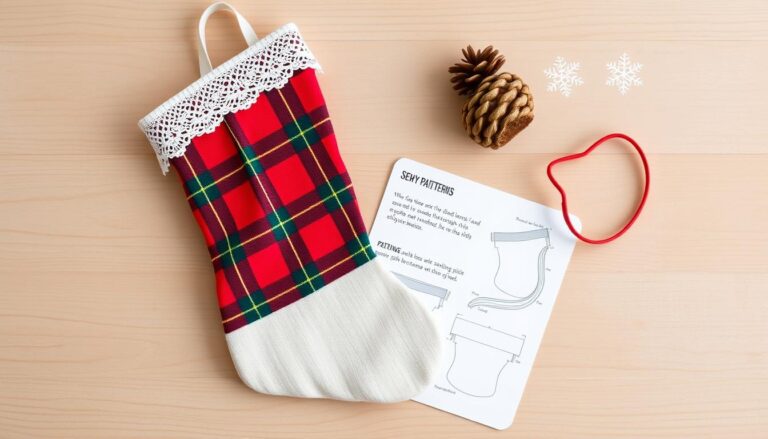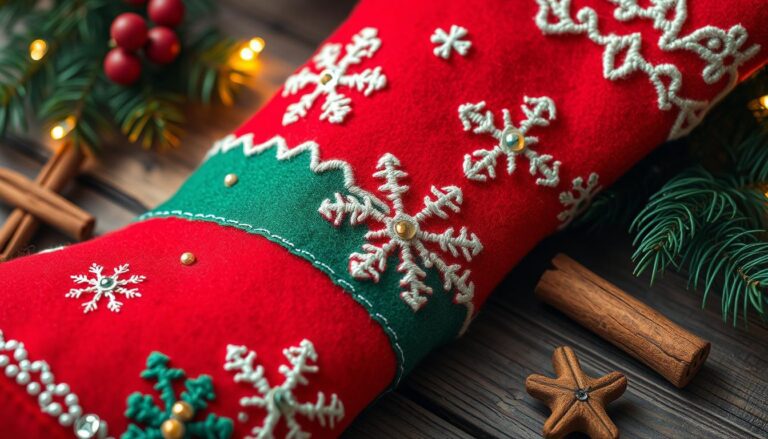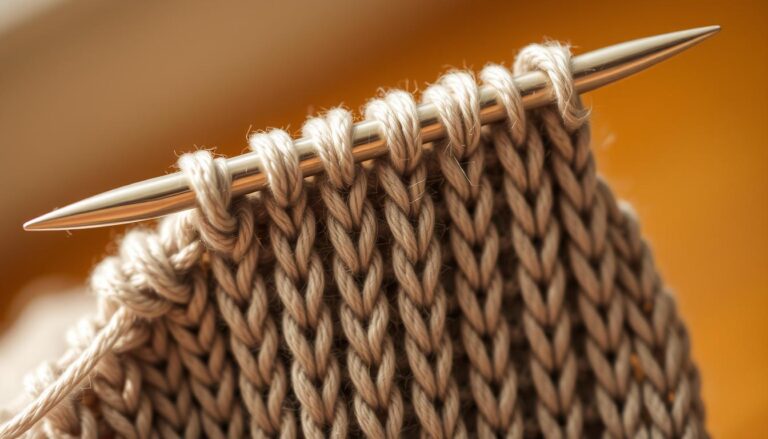What Is Stocking Stitch Knitting Pattern Guide
Welcome to the ultimate guide to stocking stitch. It’s a basic technique that turns simple yarn into stunning knitted fabrics. The stocking stitch is made by alternating knit and purl rows. This creates a smooth, versatile texture that knitters everywhere adore.
So, what is stocking stitch? It’s a basic technique where you knit on the right side and purl on the wrong side. This makes a smooth, flat surface with a unique look. It’s used to make everything from cozy sweaters to delicate accessories.
I’ve been knitting for years, and stocking stitch is one of my favorites. It’s simple but incredibly versatile. Whether you’re new to knitting or have been doing it for years, learning stocking stitch opens up a world of possibilities.
In this guide, we’ll cover everything about stocking stitch. We’ll look at its history, learn key techniques, avoid common mistakes, and explore project ideas. By the end, you’ll be confident using this beautiful stitch in your knitting.
Get ready to explore the magical world of stocking stitch. Your knitting adventure begins right here!
Understanding the Basics of Stocking Stitch
Starting to knit can seem daunting, but learning the stocking stitch is a great first step. This basic technique helps you make smooth fabric for many projects.
At first, stocking stitch might seem hard, but it’s really simple once you get it. Here’s what you need to know to start your knitting adventure.
Essential Tools and Materials
Before you start, make sure you have these important items:
- Knitting needles (straight or circular)
- Smooth, medium-weight yarn
- Scissors
- Tapestry needle for weaving in ends
Basic Terminology
Learn these key terms to get better at knitting:
| Term | Definition |
|---|---|
| Knit Stitch | Basic stitch created by pulling a loop through previous stitches |
| Purl Stitch | Reverse of knit stitch, creating a bumpy texture |
| Tension | Consistency of stitch size and tightness |
Getting Started with Stocking Stitch
To make a classic stocking stitch, you alternate between two rows:
- Knit row: Work all stitches as knit stitches
- Purl row: Work all stitches as purl stitches
The beauty of stocking stitch is in its simplicity. When worked flat, these alternating rows create a smooth, V-shaped texture on the right side of your fabric. Remember, practice makes perfect, so don’t worry if it takes a few tries to get it right!
What Is Stocking Stitch and Its History
Stocking stitch is a basic knitting pattern. It’s made by alternating knit and purl rows. This creates a smooth, uniform fabric.
The history of stocking stitch goes back to fishermen and sailors. They used it to make warm, stretchy clothing. This technique was perfect for their needs.
- Originated in maritime communities
- Used for creating warm, flexible garments
- Became a foundational knitting technique worldwide
Stocking stitch was key in textile history. Handknitters and early textile manufacturers loved it for its simplicity. It became even more popular during the industrial revolution.
The stocking stitch has a special trait. When knitted flat, it shows two sides. The right side has smooth, V-shaped stitches. The wrong side has horizontal bumpy rows.
Today, stocking stitch is a must-know for knitters. It’s used in everything from baby clothes to elegant sweaters. It’s a timeless choice for a clean, elegant finish.
Step-by-Step Stocking Stitch Tutorial
Are you ready to start your stocking stitch tutorial? Learning this skill is exciting for all crafters. It makes a smooth, classic fabric great for sweaters and scarves.
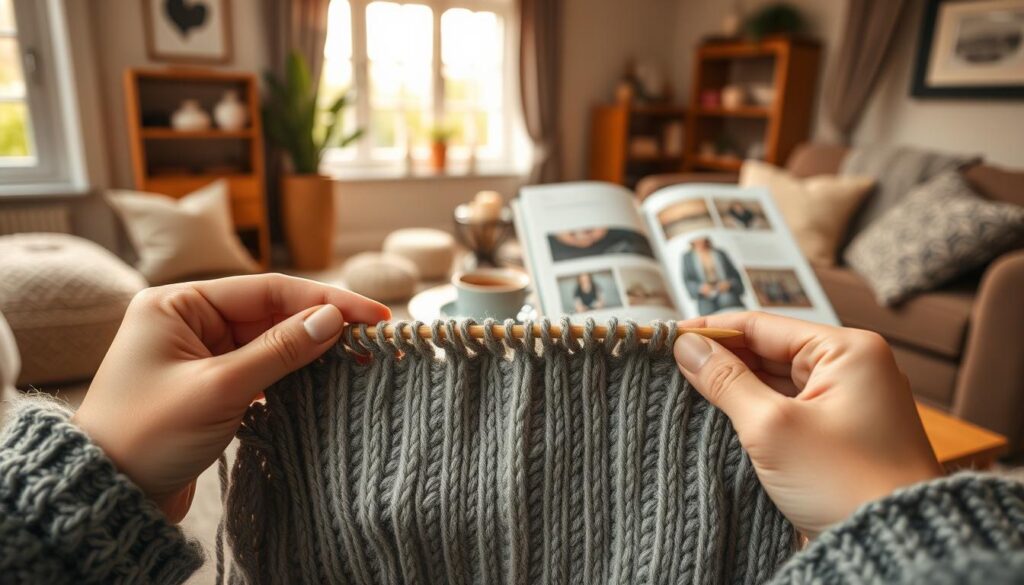
Stocking stitch uses two basic rows for a beautiful texture. I’ll show you simple steps to master this basic knitting skill.
Working the Knit Row
The knit row is your starting point. Here’s what to do:
- Hold your working yarn behind the needle
- Insert the right needle into the front of the first stitch
- Wrap the yarn counterclockwise around the needle
- Pull the new stitch through the existing loop
- Slide the old stitch off the left needle
Working the Purl Row
The purl row finishes your stocking stitch pattern. Follow these steps:
- Hold your working yarn in front of the needle
- Insert the right needle from back to front
- Wrap the yarn clockwise around the needle
- Pull the new stitch through the existing loop
- Remove the old stitch from the left needle
Maintaining Even Tension
Even tension is key for a professional look. Practice makes perfect! Here are some tips:
- Keep your yarn at a consistent angle
- Practice rhythmic, smooth movements
- Use stitch markers to track progress
- Check your work frequently
With patience and practice, you’ll make beautiful stocking stitch projects. They’ll show off your growing knitting skills.
Stocking Stitch vs. Garter Stitch: Key Differences
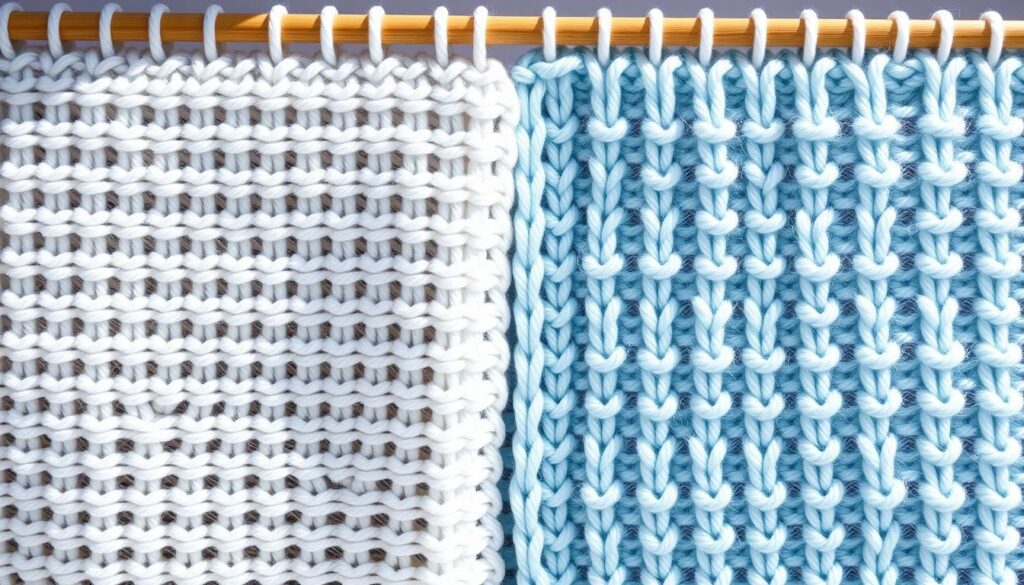
Knitters often debate the merits of stocking stitch vs. garter stitch. Both are key techniques, but they produce vastly different textures and looks.
Stocking stitch alternates knit and purl rows, making a smooth, flat fabric. It has a V-shaped texture on one side and a bumpy reverse. Garter stitch, with every row knit, creates a textured, ridged fabric.
- Stocking Stitch Characteristics:
- Smooth, elegant appearance
- Tendency to curl at the edges
- Perfect for garments requiring drape
- Garter Stitch Characteristics:
- Thick, bumpy texture
- Lies flat without curling
- Great for beginners and chunky projects
When deciding between stocking stitch and garter stitch, consider your project’s needs. Stocking stitch is ideal for sleek items like sweaters. Garter stitch works well for sturdy items like scarves and blankets.
Experienced knitters often mix these stitches for unique looks and textures. Knowing the special qualities of each stitch can spark endless creativity in your knitting.
Common Mistakes and Troubleshooting
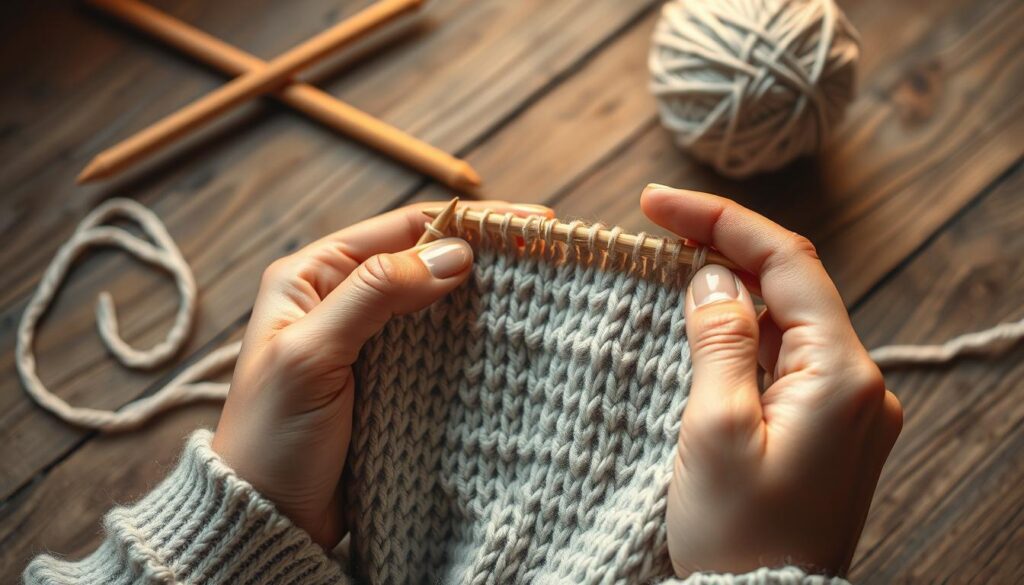
Knitting your first stocking stitch project is exciting. But, you might face some challenges. Learning how to fix these issues will help you make beautiful pieces.
Fixing Dropped Stitches
Dropped stitches are common. Here’s how to fix them:
- Identify the dropped stitch right away
- Use a crochet hook to pick up the loose stitch
- Carefully work the stitch back up through previous rows
- Make sure the stitch is back on your needle correctly
Preventing Edge Curling
Stocking stitch edges often curl. Here are some tips to stop this:
- Add a border of garter or ribbing stitches
- Block your finished project to flatten edges
- Use slightly larger needles for the edge stitches
Managing Tension Issues
Keeping your tension even is important. Here’s how to improve:
- Practice keeping your yarn tension even
- Use stitch markers to track your progress
- Take breaks to relax your hands
- Compare your work to reference images
Remember, every knitting challenge is an opportunity to improve your skills! With patience and practice, you’ll soon create smooth, professional-looking stocking stitch projects.
Advanced Techniques and Variations
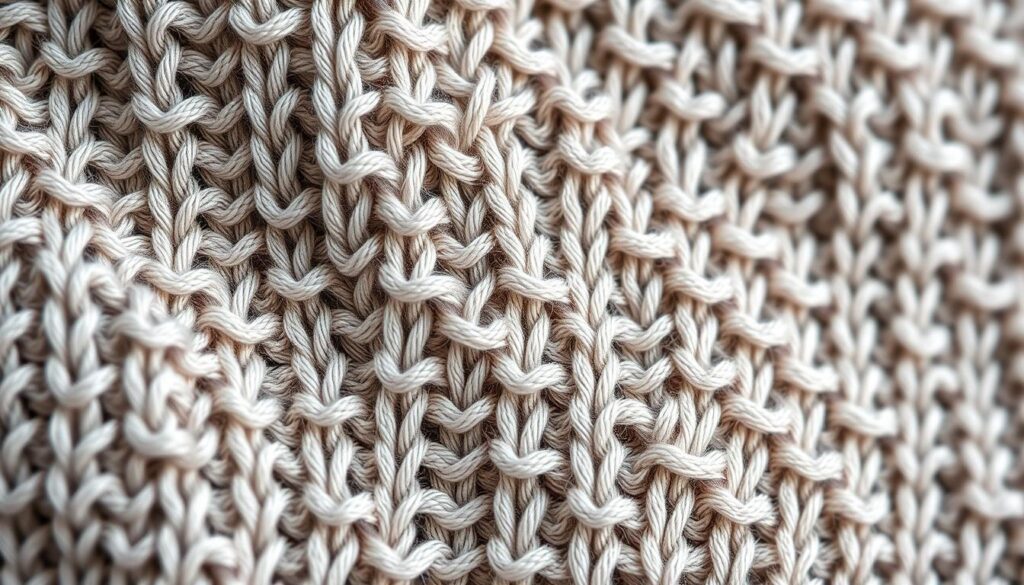
To make your stocking stitch patterns stand out, you need creativity and skill. Knitters can explore new ways to make simple stitches look amazing. This can turn basic techniques into eye-catching designs.
Advanced stocking stitch patterns let you express yourself in new ways. Here are some cool techniques to elevate your knitting:
- Slip Stitch Color Work
- Textured Stocking Stitch Variations
- Decorative Edge Techniques
- Integrated Pattern Modifications
Going beyond the basic stocking stitch opens up a world of creativity. Here are some advanced techniques to try:
| Technique | Difficulty Level | Visual Effect |
|---|---|---|
| Slip Stitch Colorwork | Intermediate | Intricate Design Patterns |
| Textured Stocking Stitch | Advanced | Dimensional Surface Patterns |
| Decorative Edge Techniques | Intermediate | Refined Finishing |
Learning these advanced techniques takes time and effort. Start with simpler ones and then move to more complex ones. Each new skill will make you a better knitter and boost your confidence.
Projects Perfect for Stocking Stitch
Stocking stitch patterns are great for knitters of all levels. They can turn simple projects into beautiful works of art. Whether you’re new to knitting or want to try something more complex, this stitch is perfect.
Let’s look at some exciting projects that highlight the beauty of stocking stitch. You’ll find everything from easy beginner projects to more complex designs. This stitch can really take your knitting to the next level.
Beginner-Friendly Projects
New knitters can start with simple stocking stitch patterns. These projects help build confidence and skills. Here are some great options:
- Simple scarves
- Washcloths
- Basic baby blankets
- Rectangular cushion covers
Intermediate Level Projects
When you get more comfortable with stocking stitch, try these projects:
- Lightweight sweaters
- Gradient-colored shawls
- Fitted tank tops
- Elegant cardigans
Advanced Applications
Advanced knitters can use stocking stitch for complex garments. Intricate color work and textured designs can make this basic stitch truly special.
- Lace-trimmed pullovers
- Intricate color-block sweaters
- Textured winter coats
- Sophisticated evening wear
Tips for Perfecting Your Stocking Stitch
Mastering stocking stitch takes practice and focus. I’ll share key tips to boost your knitting skills. These will help you make projects that look professional.
When learning stocking stitch, being consistent is vital. Here are important techniques to enhance your skill:
- Check your tension regularly using a gauge swatch
- Practice maintaining even stitches on both knit and purl rows
- Use high-quality needles that feel comfortable in your hands
- Select smooth, consistent yarn for best results
To get a polished stocking stitch, try these advanced tips:
| Technique | Benefit |
|---|---|
| Blocking | Evens out stitches and improves overall appearance |
| Needle Size | Matches yarn weight for optimal stitch definition |
| Consistent Tension | Creates smooth, professional-looking fabric |
Pro tip: Practice your stocking stitch on small swatches before starting larger projects to build muscle memory and confidence.
Remember, becoming good at stocking stitch takes time. Don’t get discouraged if your first tries aren’t perfect. Every row you knit will make you better.
Care and Maintenance of Stocking Stitch Projects
To keep your stocking stitch projects looking great, you need to take good care of them. This type of knitting is strong and easy to care for, making it perfect for knitting fans.
First, understand what makes stocking stitch fabric special. It’s delicate and needs gentle care to keep its texture and look just right.
Washing Techniques
- Use lukewarm water for washing
- Select mild, wool-friendly detergents
- Avoid harsh wringing or twisting
- Gently squeeze out excess water
When you wash your stocking stitch items carefully, you’ll see their beauty. Handwashing is the best way to keep your knits in top shape.
Storage Recommendations
| Storage Method | Best Practices |
|---|---|
| Folding | Fold loosely to prevent permanent creasing |
| Hanging | Use padded hangers for delicate garments |
| Protection | Store in breathable garment bags |
Pro tip: Always store stocking stitch projects flat when possible to maintain their shape and prevent stretching.
Preventing Common Issues
- Rotate wearing to reduce fabric stress
- Use fabric shavers for managing pilling
- Avoid direct sunlight during drying
- Reshape garments while damp
By following these care tips, your stocking stitch projects will last longer. They’ll stay beautiful and useful for many years.
Combining Stocking Stitch with Other Patterns
Knitters can take their skills to the next level by mixing stocking stitch with other patterns. This stitch is smooth and versatile, making it perfect for adding new designs.
To master these combinations, you need to know how different stitches work together. Designers often use stocking stitch as a base for more complex designs.
Popular Pattern Combinations
- Cable knit overlays on stocking stitch backgrounds
- Lace panels integrated within stocking stitch sections
- Colorwork designs using stocking stitch as a neutral foundation
- Textured stripe patterns alternating with smooth stocking stitch
Creating Texture and Interest
To make your projects stand out, try different stocking stitch patterns. Introducing contrasting techniques like ribbing or seed stitch can make a big difference.
Some ways to add depth include:
- Incorporating slip-stitch patterns
- Using strategic yarn weight changes
- Mixing different stitch heights
- Introducing subtle color transitions
By learning to mix stocking stitch with other stitches, you can make unique and personal projects. These projects will show off your creativity and skill.
Conclusion
Stocking stitch in knitting is a key skill for all crafters. It’s not just for making fabric. It opens up a world of creative possibilities.
Learning to knit stocking stitch takes time and effort. But with each project, you’ll get better and more confident. Its simplicity and flexibility make it perfect for many projects, from scarves to sweaters.
Try out different yarns and needles to see what works best for you. Stocking stitch is a canvas for your creativity, no matter your skill level. Remember, mistakes are chances to learn and improve.
Your knitting journey is special and yours alone. Enjoy the flow of stitches and the journey of making something new. The knitting world is full of adventures, one stitch at a time.
